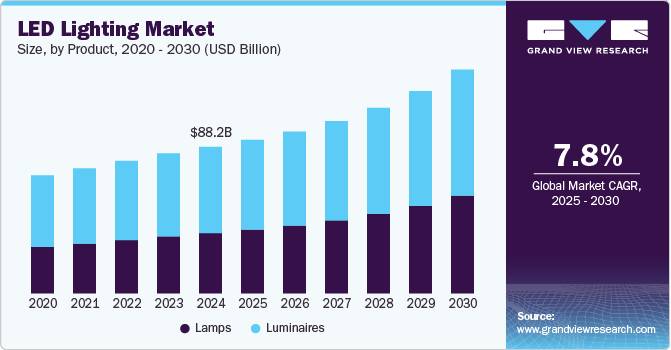LED Lighting Market Size, Share & Trends Analysis growing at a CAGR of 7.8% from 2025 to 2030

The global LED lighting market size was estimated at USD 88.17 billion in 2024 and is projected to reach USD 134.71 billion by 2030, growing at a CAGR of 7.8% from 2025 to 2030. The market growth is primarily driven by the surge in construction activities across both developing and developed nations, coupled with government regulations aimed at phasing out inefficient lighting systems.
Key Market Trends & Insights
- Asia Pacific dominated the LED lighting market with the largest revenue share of 39.72% in 2024.
- The LED lighting market in the U.S. is anticipated to witness at a significant CAGR from 2025 to 2030.
- Based on product, the luminaires segment led the market with the largest revenue share of 58.91% in 2024.
- Based on application, the indoor segment led the market with the largest revenue share of 67.75% in 2024.
- Based on end use, the commercial segment led the market with the largest revenue share of 51.11% in 2024.
Market Size & Forecast
- 2024 Market Size: USD 88.17 Billion
- 2030 Projected Market Size: USD 134.71 Billion
- CAGR (2025-2030): 7.8%
- Asia Pacific: Largest market in 2024
Request a free sample copy or view report summary: https://www.grandviewresearch.com/industry-analysis/led-lighting-market/request/rs1
In addition, supportive government initiatives to reduce the cost of LED lighting are further propelling market expansion.
Manufacturers are increasingly integrating advanced features like Wi-Fi connectivity, occupancy sensors, and daylight harvesting technologies to boost sales. Moreover, market players are offering a wide range of LED products, including LED strips, bulbs, and tube lights, to cater to a broad customer base, thereby contributing to the overall growth of the LED lighting industry.
LED lights are often considered a superior lighting option compared to traditional alternatives such as incandescent, CFL, and halogen bulbs. They provide high-quality illumination while requiring minimal energy input. Their efficiency and versatility make them suitable for a wide range of applications, both indoors and outdoors. LED technology offers design flexibility and can withstand frequent on-off switching, which adds to its appeal for various lighting needs. With increasing consumer awareness of these benefits, the market for LED lighting is expected to grow steadily.
Regulatory bodies such as the American National Standards Institute (ANSI), China Compulsory Certification (CCC), and the International Electrotechnical Commission (IEC) play a key role in certifying LED types. Manufacturers must obtain the necessary licenses and approvals before entering the market, offering services, or engaging in international trade. Both developed and developing nations are actively promoting energy conservation, driving the demand for LED lamps and bulbs.






